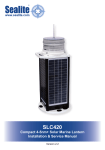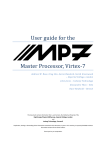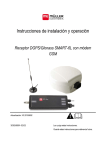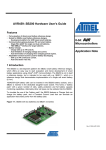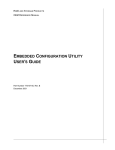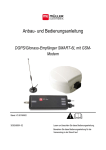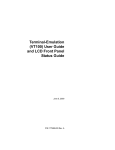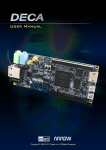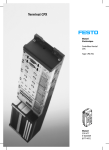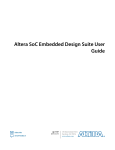Download MAX 10 FPGA Development Kit User Guide
Transcript
MAX 10 FPGA Development Kit User Guide Subscribe Send Feedback UG-01169 2015.11.06 101 Innovation Drive San Jose, CA 95134 www.altera.com TOC-2 Contents Overview.............................................................................................................. 1-1 General Description.....................................................................................................................................1-2 Handling the Board..................................................................................................................................... 1-4 Getting Started.................................................................................................... 2-1 Quartus II Web Edition Software.............................................................................................................. 2-1 Installing the Development Kit..................................................................................................................2-1 Installing the USB-Blaster Driver.............................................................................................................. 2-2 Board Update Portal.................................................................................................................................... 2-2 Board Test System............................................................................................... 3-1 Using the Configure Menu......................................................................................................................... 3-3 The System Info Tab....................................................................................................................................3-5 The GPIO Tab.............................................................................................................................................. 3-7 The Flash Tab............................................................................................................................................... 3-9 The HSMC Tab.......................................................................................................................................... 3-11 The DDR3 Tab........................................................................................................................................... 3-13 The ADC Tab............................................................................................................................................. 3-15 The HDMI Tab...........................................................................................................................................3-17 The Sleep Mode Tab.................................................................................................................................. 3-18 The Power Monitor................................................................................................................................... 3-20 The Clock Control..................................................................................................................................... 3-22 Board Components..............................................................................................4-1 Board Overview............................................................................................................................................4-1 Featured Device............................................................................................................................................4-3 Configuration............................................................................................................................................... 4-4 Using the Quartus II Programmer................................................................................................ 4-4 Selecting the Internal Configuration Scheme.............................................................................. 4-4 Switch and Jumper Settings............................................................................................................ 4-5 Status Elements............................................................................................................................................ 4-7 Setup Elements............................................................................................................................................. 4-7 General User Input/Output........................................................................................................................4-8 Clock Circuitry............................................................................................................................................. 4-9 On-Board Oscillators.....................................................................................................................4-10 Off-Board Clock Input/Output....................................................................................................4-11 Components and Interfaces..................................................................................................................... 4-12 10/100/1000 Ethernet PHY...........................................................................................................4-12 Digital-to-Analog Converter........................................................................................................ 4-15 HDMI Video Output.....................................................................................................................4-15 Altera Corporation TOC-3 HSMC.............................................................................................................................................. 4-17 Pmod Connectors.......................................................................................................................... 4-24 USB to UART................................................................................................................................. 4-25 Memory....................................................................................................................................................... 4-25 DDR3 Rev. B Board....................................................................................................................... 4-25 DDR3 Rev. C Board.......................................................................................................................4-28 Flash................................................................................................................................................. 4-30 Power Distribution System.......................................................................................................................4-32 Additional Information......................................................................................A-1 Board & User Guide Revision History.....................................................................................................A-1 Compliance and Conformity Statements................................................................................................ A-2 CE EMI Conformity Caution........................................................................................................ A-2 Altera Corporation Overview 1 2015.11.06 UG-01169 Subscribe Send Feedback The MAX® 10 FPGA development board provides a hardware platform for evaluating the performance and features of the Altera® MAX 10 device. The development kit includes a RoHS- and CE-compliant MAX 10 FPGA Development board with the following components: • Featured Devices: • MAX 10 FPGA (10M50D, dual supply, F484 package) • Enpirion® EN2342QI 4 A PowerSoC Voltage-Mode Synchronous Step-Down Converter with Integrated Inductor Enpirion • EN6337QI 3 A High-Efficiency PowerSoC DC-DC Step-Down Converters with Integrated Inductor • Enpirion EP5358xUI 600 mA PowerSoC DC-DC Step-Down Converters with Integrated Inductor • MAX II CPLD – EPM1270M256C4N (On-board USB-Blaster™ II) • Programming and Configuration: • Embedded USB-Blaster II (JTAG) • Optional JTAG direct via 10-pin header • Memory Devices: • 64-Mx16 1 Gb DDR3 SDRAM with soft memory controller • 128-Mx8 1 Gb DDR3 SDRAM with soft memory controller • 512-Mb Quad serial peripheral interface (quad SPI) flash • Communication Ports: • Two Gigabit Ethernet (GbE) RJ-45 ports • • • • • Ethernet Port A (Bottom) • Ethernet Port B (Top) One mini-USB2.0 UART One high-definition multimedia interface (HDMI) video output One universal high-speed mezzanine card (HSMC) connector Two 12-pin Digilent Pmod™ compatible connectors © 2015 Altera Corporation. All rights reserved. ALTERA, ARRIA, CYCLONE, ENPIRION, MAX, MEGACORE, NIOS, QUARTUS and STRATIX words and logos are trademarks of Altera Corporation and registered in the U.S. Patent and Trademark Office and in other countries. All other words and logos identified as trademarks or service marks are the property of their respective holders as described at www.altera.com/common/legal.html. Altera warrants performance of its semiconductor products to current specifications in accordance with Altera's standard warranty, but reserves the right to make changes to any products and services at any time without notice. Altera assumes no responsibility or liability arising out of the application or use of any information, product, or service described herein except as expressly agreed to in writing by Altera. Altera customers are advised to obtain the latest version of device specifications before relying on any published information and before placing orders for products or services. www.altera.com 101 Innovation Drive, San Jose, CA 95134 ISO 9001:2008 Registered 1-2 UG-01169 2015.11.06 General Description • Analog: • • • • Two MAX 10 FPGA analog-to-digital converter (ADC) SMA inputs 2x10 ADC header Potentiometer input to ADC One external 16 bit digital-to-analog converter (DAC) device with SMA output • Clocking • 25 MHz single-ended, external oscillator clock source • Silicon labs clock generator with programmable frequency GUI • Mini-USB cable for on-board USB-Blaster™ II • 2A Power Supply and cord • Free Quartus® II Web Edition design software (download software and license from website) • Complete documentation • User manual, bill of materials, schematic, and board files General Description Figure 1-1: MAX 10 FPGA Board Components (Top) 2x10 PIN HEADER (J20) POT1 USB BLASTER (J12) CLOCK GENERATION CHIP USB to UART (J11) JTAG HEADER (J14) MAX II USB-BLASTER II CIRCUIT HDMI CONNECTOR (J8) FPGA_CPU_RESET BUTTON PMOD CONNECTOR (J5) USER PUSH BUTTONS SMA - ANAIN2 (J19) USER PB3 USER PB2 USER PB1 USER PB0 SMA - ANAIN1 (J18) PMOD CONNECTOR (J4) FPGA RECONFIGURE BUTTON POWER SWITCH (SW3) SMA - DACOUT (J1) 16-Bit DAC DC INPUT 12 V (J15) DUAL ETHERNET CONNECTOR (RJ1) Ethernet A (Bottom) Ethernet B (Top) LED4 LED3 LED2 LED1 LED0 USER LEDs Altera Corporation DDR3 64Mx16 SDRAM Enpirion EN6337 3A PowerSoC Enpirion EN2342QI 4A HSMC CONNECTOR PowerSoC (J2) Overview Send Feedback UG-01169 2015.11.06 General Description 1-3 Figure 1-2: MAX 10 FPGA Board Components (Bottom) Note: To determine the revision of your board, look for the serial number at the bottom of the board. QUAD SPI FLASH ENPIRION EN6337 USER DIP SWITCH (SW2) USER DIP SWITCH (SW1) DDR3 128Mx8 SDRAM (U6) Overview Send Feedback BOARD REVISON ENPIRION EN6337 Altera Corporation 1-4 UG-01169 2015.11.06 Handling the Board Figure 1-3: System Block Diagram DC Supply USB Blaster FTDI + MAXII/ V HDMI TX USB to UART DDR 3 512 Mb x16 2x 1 GbE QSPI Flash 1 Gb x16 HSMC 2x10 ADC IN/GPI O PMOD DACOUT DAC PMOD AIN1 AIN2 Potentiometer Qsci llator User LEDs ~ ~ FPGA _RESET JTAG User DIP Switches User Push Buttons Handling the Board When handling the board, it is important to observe static discharge precautions. Caution: Without proper anti-static handling, the board can be damaged. Therefore, use anti-static handling precautions when touching the board. Altera Corporation Overview Send Feedback 2 Getting Started 2015.11.06 UG-01169 Subscribe Send Feedback Quartus II Web Edition Software The Quartus II Web Edition Software is a free with no license required. You can download the Web Edition software from the Altera website. Alternatively, you can request a DVD. Related Information • Quartus II Web Edition Software • Altera IP and Software DVD Request Form • Altera Quartus II Software - Subscription Edition vs. Web Edition Installing the Development Kit 1. Download the MAX 10 Development Kit installer from the MAX 10 FPGA Development Kit page of the Altera website. Alternatively, you can request a development kit DVD from the Altera Kit Installa‐ tions DVD Request Form page of the Altera website. 2. Run the MAX 10 FPGA Development Kit installer. 3. Follow the on-screen instructions to complete the installation process. Be sure that the installation directory you choose is in the same relative location to the Quartus II software installation. The installation program creates the development kit directory structure shown in the following figure. Attention: .sof files are used by BTS GUI to configure the MAX 10 device and start corresponding test. Therefore, do not to move the .sof files from the *\examples\board_test_system directory. © 2015 Altera Corporation. All rights reserved. ALTERA, ARRIA, CYCLONE, ENPIRION, MAX, MEGACORE, NIOS, QUARTUS and STRATIX words and logos are trademarks of Altera Corporation and registered in the U.S. Patent and Trademark Office and in other countries. All other words and logos identified as trademarks or service marks are the property of their respective holders as described at www.altera.com/common/legal.html. Altera warrants performance of its semiconductor products to current specifications in accordance with Altera's standard warranty, but reserves the right to make changes to any products and services at any time without notice. Altera assumes no responsibility or liability arising out of the application or use of any information, product, or service described herein except as expressly agreed to in writing by Altera. Altera customers are advised to obtain the latest version of device specifications before relying on any published information and before placing orders for products or services. www.altera.com 101 Innovation Drive, San Jose, CA 95134 ISO 9001:2008 Registered 2-2 UG-01169 2015.11.06 Installing the USB-Blaster Driver Figure 2-1: Installed Development Kit Directory Structure <install dir> The default Windows installation directory is C:\altera\<version>\. kits <device name> board_design_files demos documents examples factory_recovery Table 2-1: Installed Directory Contents Directory Name Description of Contents board_design_files Contains schematic, layout, assembly, and bill of material board design files. Use these files as a starting point for a new prototype board design. demos Contains demonstration applications when available. documents Contains the following documentation: • MAX 10 FPGA Development Kit User Guide • Quick Start Guide • Dear Customer Letter examples Contains the sample design files for this kit. factory_recovery Contains the original data programmed onto the board before shipment. Use this data to restore the board with its original factory contents. Installing the USB-Blaster Driver The development board includes integrated USB-Blaster circuitry for FPGA programming. However, for the host computer and board to communicate, you must install the On-Board USB-Blaster II driver on the host computer. Installation instructions for the On-Board USB-Blaster II driver for your operating system are available on the Altera website. On the Altera Programming Cable Driver Information page of the Altera website, locate the table entry for your configuration and click the link to access the instructions. Board Update Portal You can keep your board current by accessing the Board Update Portal on www.altera.com. Altera Corporation Getting Started Send Feedback UG-01169 2015.11.06 Board Update Portal 2-3 This web site allows you access useful information and updated software and design examples for your board. For instructions on setting up your board to access the Board Update Portal, consult the printed Quick Start Guide that is included in the kit box. Getting Started Send Feedback Altera Corporation Board Test System 3 2015.11.06 UG-01169 Subscribe Send Feedback This kit includes an application called the Board Test System (BTS). The BTS provides an easy-to-use interface to alter functional settings and observe the results. You can use the BTS to test board components, modify functional parameters, observe performance, and measure power usage. While using the BTS, you reconfigure the FPGA several times with test designs specific to the functionality you are testing. © 2015 Altera Corporation. All rights reserved. ALTERA, ARRIA, CYCLONE, ENPIRION, MAX, MEGACORE, NIOS, QUARTUS and STRATIX words and logos are trademarks of Altera Corporation and registered in the U.S. Patent and Trademark Office and in other countries. All other words and logos identified as trademarks or service marks are the property of their respective holders as described at www.altera.com/common/legal.html. Altera warrants performance of its semiconductor products to current specifications in accordance with Altera's standard warranty, but reserves the right to make changes to any products and services at any time without notice. Altera assumes no responsibility or liability arising out of the application or use of any information, product, or service described herein except as expressly agreed to in writing by Altera. Altera customers are advised to obtain the latest version of device specifications before relying on any published information and before placing orders for products or services. www.altera.com 101 Innovation Drive, San Jose, CA 95134 ISO 9001:2008 Registered 3-2 Board Test System UG-01169 2015.11.06 Figure 3-1: Board Test System GUI Several designs are provided to test the major board features. Each design provides data for one or more tabs in the application. The Configure menu identifies the appropriate design to download to the FPGA for each tab. After successful FPGA configuration, the appropriate tab appears that allows you to exercise the related board features. Highlights appear in the board picture around the corresponding components The BTS communicates over the JTAG bus to a test design running in the FPGA. The Board Test System and Power Monitor share the JTAG bus with other applications like the Nios II debugger and the SignalTap® II Embedded Logic Analyzer. Because the Quartus II programmer uses most of the bandwidth of the JTAG bus, other applications using the JTAG bus might time out. Be sure to close the other applica‐ tions before attempting to reconfigure the FPGA using the Quartus II Programmer. Altera Corporation Board Test System Send Feedback UG-01169 2015.11.06 Using the Configure Menu 3-3 Using the Configure Menu Use the Configure menu to select the design you want to use. Each design example tests different board features. Choose a design from this menu and the corresponding tabs become active for testing. Figure 3-2: The Configure Menu Board Test System Send Feedback Altera Corporation 3-4 Using the Configure Menu UG-01169 2015.11.06 To configure the FPGA with a test system design, perform the following steps: 1. On the Configure menu, click the configure command that corresponds to the functionality you wish to test. 2. In the dialog box that appears, click Configure to download the corresponding design to the FPGA. 3. When configuration finishes, close the Quartus II Programmer if open. The design begins running in the FPGA. The corresponding GUI application tabs that interface with the design are now enabled. If you use the Quartus II Programmer for configuration, rather than the Board Test System GUI, you may need to restart the GUI. Altera Corporation Board Test System Send Feedback UG-01169 2015.11.06 The System Info Tab 3-5 The System Info Tab The System Info tab shows the board’s current configuration. The tab displays the JTAG chain, the board’s MAC address, the Qsys memory map, and other details stored on the board. Figure 3-3: The System Info Tab Board Test System Send Feedback Altera Corporation 3-6 UG-01169 2015.11.06 The System Info Tab Table 3-1: Controls on the System Info Tab Controls Description Board Information Controls The board information is updated once the GPIO design is configured. Otherwise, this control displays the default static information about your board. Board Name Indicates the official name of the board, given by the Board Test System. Board P/N Indicates the part number of the board. Serial Number Indicates the serial number of the board. Factory Test Version Indicates the version of the Board Test System currently running on the board. MAX Version Indicates the version of MAX code currently running on the board. Ethernet A MAC Indicates the Ethernet A MAC address of the board. Ethernet B MAC Indicates the Ethernet B MAC address of the board. JTAG Chain Shows all the devices currently in the JTAG chain. Qsys Memory Map Shows the memory map of the Qsys system on your board. Altera Corporation Board Test System Send Feedback UG-01169 2015.11.06 The GPIO Tab 3-7 The GPIO Tab The GPIO tab allows you to interact with all the general purpose user I/O components on your board. You can read DIP switch settings, turn LEDs on or off, and detect push button presses. Figure 3-4: The GPIO Tab Table 3-2: Controls on the GPIO Tab User DIP Switch Board Test System Send Feedback Displays the current positions of the switches in the user DIP switch banks. Change the switches on the board to see the graphical display change accordingly. Altera Corporation 3-8 The GPIO Tab UG-01169 2015.11.06 User LEDs Displays the current state of the user LEDs for the FPGA. To toggle the board LEDs, click the 0 to 4 buttons to toggle red or green LEDs, or click the All button. Push Button Switches Read-only control displays the current state of the board user push buttons. Press a push button on the board to see the graphical display change accordingly. Altera Corporation Board Test System Send Feedback UG-01169 2015.11.06 The Flash Tab 3-9 The Flash Tab The Flash Tab allows you to read and write flash memory on your board. Figure 3-5: The Flash Tab (Detail) Control Read Board Test System Send Feedback Description Reads the flash memory on your board. To see the flash memory contents, type a starting address in the text box and click Read. Values starting at the specified address appear in the table. Altera Corporation 3-10 UG-01169 2015.11.06 The Flash Tab Control Description Write Writes the flash memory on your board. To update the flash memory contents, change values in the table and click Write. The application writes the new values to flash memory and then reads the values back to guarantee that the graphical display accurately reflects the memory contents. Erase Erases flash memory. Increment Test Starts an incrementing data pattern test to flash memory, limited to the 512 K test system scratch page. Random Test Starts a random data pattern test to flash memory, limited to the 512 K test system scratch page. Flash Memory Map Displays the flash memory map for the development board. Altera Corporation Board Test System Send Feedback UG-01169 2015.11.06 The HSMC Tab 3-11 The HSMC Tab The HSMC Tab allows you to test the CMOS port. Figure 3-6: The HSMC Tab Control Description Status Pattern sync: Shows the pattern synced or not synced state. The pattern is considered synced when the start of the data sequence is detected. Port CMOS: The CMOS port is available for tests. Board Test System Send Feedback Altera Corporation 3-12 UG-01169 2015.11.06 The HSMC Tab Control Data Type Description The following data types are available for analysis: • • • • • • prbs7: Selects pseudo-random 7-bit sequences. prbs15: Selects pseudo-random 15-bit sequences. prbs23: Selects pseudo-random 23-bit sequences. prbs31: Selects pseudo-random 31-bit sequences. high_frequency: Divide by data pattern. low_frequency: Divide by data pattern. Error Control • Detected errors: Displays the number of data errors detected in the hardware. • Inserted errors: Displays the number of errors inserted into the transmit data stream. • Bit error rate (BER): Displays the bit error rate of the interface • Insert Error: Inserts a one-word error into the transmit data stream each time you click the button. • Clear: Resets the Detected errors and Inserted errors counters to zeroes. Test Control • Stop: Resets the test. • Number of bits tested: Displays the number of bits tested since the last reset. Altera Corporation Board Test System Send Feedback UG-01169 2015.11.06 The DDR3 Tab 3-13 The DDR3 Tab The DDR3 Tab allows you to test the DDR3 by reading and writing to a selected amount of addresses. Figure 3-7: The DDR3 Tab Board Test System Send Feedback Altera Corporation 3-14 UG-01169 2015.11.06 The DDR3 Tab Control Performance Indicators Description These controls display current transaction performance analysis information collected since you last clicked Start: • Write, Read, and Total performance bars—Show the percentage of maximum theoretical data rate that the requested transactions are able to achieve. • Write (MBps), Read (MBps), and Total (MBps)—Show the number of bytes of data analyzed per second. • Data bus: 72 bits (8 bits ECC) wide and the frequency is 1066 MHz double data rate. 2133 Megabits per second (Mbps) per pin. Equating to a theoretical maximum bandwidth of 136512 Mbps or 17064 MBps. Error Control This control displays data errors detected during analysis and allows you to insert errors: • Detected errors—Displays the number of data errors detected in the hardware. • Inserted errors—Displays the number of errors inserted into the transaction stream. • Insert Error—Inserts a one-word error into the transaction stream each time you click the button. Insert Error is only enabled during transaction performance analysis. • Clear—Resets the Detected errors and Inserted errors counters to zeroes. Number of Addresses to Write and Read Altera Corporation Determines the number of addresses to use in each iteration of reads and writes. Board Test System Send Feedback UG-01169 2015.11.06 The ADC Tab 3-15 The ADC Tab The ADC Tab (analog-to-digital) shows the real-time voltage values of all of the ADC input channels. Figure 3-8: The ADC Tab The two tables displayed on this tab, ADC 1 and ADC 2 are not editable. The following table shows where the channels connect to. Dedicated Channel SMA Connector ADC 1 ANAIN1_SMA(J18) Channel0 Board Test System Send Feedback ADC1_CH0(J20.1) Altera Corporation 3-16 UG-01169 2015.11.06 The ADC Tab Dedicated Channel SMA Connector ADC 1 ANAIN1_SMA(J18) Channel1 ADC1_CH1(J20.3) Channel2 ADC1_CH2(J20.5) Channel3 ADC1_CH2(J20.7) Channel4 ADC1_CH4(J20.11) Channel5 ADC1_CH4(J20.13) Channel6 ADC1_CH6(J20.15 or POT1) Channel7 ADC1_CH7(J20.17) Dedicated Channel SMA Connector ADC 2 ANAIN2_SMA(J19) Channel0 ADC1_CH0(J20.2) Channel1 ADC1_CH1(J20.4) Channel2 ADC1_CH2(J20.6) Channel3 ADC1_CH2(J20.8) Channel4 ADC1_CH4(J20.12) Channel5 ADC1_CH4(J20.14) Channel6 ADC1_CH6(J20.16) Channel7 ADC1_CH7(J20.18) Altera Corporation Board Test System Send Feedback UG-01169 2015.11.06 The HDMI Tab 3-17 The HDMI Tab This tab displays a transmitter color bar pattern from the high-definition multimedia interface (HDMI). Figure 3-9: The HDMI Tab Control Description TX Pattern Color Bar: Use this control to choose TX patterns. The available choices are red, blue, green, white, and black. If you select the Start button, the TX pattern displays immediately. Start When you click this button, the selected TX pattern (from Color Bar) displays. Board Test System Send Feedback Altera Corporation 3-18 UG-01169 2015.11.06 The Sleep Mode Tab The Sleep Mode Tab This tab allows you to test the sleep mode aspect of the power management controller. Figure 3-10: The Sleep Mode Tab (Cropped View) Control Description running (/sleeping) This control displays the mode status as sleeping or running. It is not interactive. Note This control displays board LED events related to the sleep mode. Altera Corporation Board Test System Send Feedback UG-01169 2015.11.06 The Sleep Mode Tab 3-19 Related Information MAX 10 Power Management User Guide Provides details on the sleep mode. Board Test System Send Feedback Altera Corporation 3-20 UG-01169 2015.11.06 The Power Monitor The Power Monitor The Power Monitor measures and reports current power information and communicates with the MAX II device on the board through the JTAG bus. A power monitor circuit attached to the MAX II device allows you to measure the power that the FPGA is consuming. To start the application, click the Power Monitor icon in the Board Test System application. You can also run the Power Monitor as a stand-alone application. The PowerMonitor(32-bit.exe) and PowerMonitor(64bit.exe) reside in the <install dir>\kits\<device name>\examples\board_test_system directory. Note: You cannot run the stand-alone power application and the BTS application at the same time. Figure 3-11: The Power Monitor This window displays both LTC2990 current and temperature monitors. The left side top and bottom quadrant shows U29 and the opposite side shows U30. Use the available controls to show Current or Voltage Single-Ended, or both. Single Chart Mode allows you to choose how you want the panes to display. You can show only a single large pane, if needed. Voltage Single-Ended shows the voltage value of each power rail: Altera Corporation Board Test System Send Feedback UG-01169 2015.11.06 The Power Monitor • • • • 3-21 2.5 V CORE 2.5 V VCCIO 1.5 V VCCIO 1.2 VVCC Single-ended shows the voltage of SENSE_P only. The LT2990 also shows a differential voltage value of the sampling resistor SENSE_P and SENSE_N. Sample Speed allows you to select Slow at 5 seconds, or Fast: at 1 second (default). Record Log saves a comma-separated values (CSV) format file ltc2990.csv in the *\examples\board_test_ system directory. Board Test System Send Feedback Altera Corporation 3-22 UG-01169 2015.11.06 The Clock Control The Clock Control The MAX 10 FPGA development board Clock Control application sets the programmable oscillators to any frequency between 10 MHz and 810 MHz. The frequencies support eight digits of precision to the right of the decimal point. The Clock Control communicates with the MAX II device on the board through the JTAG bus. The programmable oscillators are connected to the MAX II device through a 2-wire serial bus. Figure 3-12: The Si570 Tab Control Description Serial Port Registers Shows the current values from the Si570 registers for frequency configuration. Target frequency (MHZ) Allows you to specify the frequency of the clock. Legal values are between 10 and 810 MHz with eight digits of precision to the right of the decimal point. For example, 421.31259873 is possible within 100 parts per million (ppm). The Target frequency control works in conjunction with the Set New Freq control. fXTAL Shows the calculated internal fixed-frequency crystal, based on the serial port register values. Default Sets the frequency for the oscillator associated with the active tab back to its default value. This can also be accomplished by power cycling the board. Read Reads the current frequency setting for the oscillator associated with the active tab. Altera Corporation Board Test System Send Feedback UG-01169 2015.11.06 The Clock Control Control Set New Freq 3-23 Description Sets the programmable oscillator frequency for the selected clock to the value in the Target frequency control for the programmable oscillators. Frequency changes might take several milliseconds to take effect. You might see glitches on the clock during this time. Altera recommends resetting the FPGA logic after changing frequencies. Figure 3-13: The Si5338 Tab Control Description F_vco Displays the generating signal value of the voltage-controlled oscillator. Registers Display the current frequencies for each oscillator. Frequency (MHz) Allows you to specify the frequency of the clock. Disable Disable each oscillators as required. Read Reads the current frequency setting for the oscillator associated with the active tab. Default Sets the frequency for the oscillator associated with the active tab back to its default value. This can also be accomplished by power cycling the board. Board Test System Send Feedback Altera Corporation 3-24 UG-01169 2015.11.06 The Clock Control Control Set New Freq Description Sets the programmable oscillator frequency for the selected clock to the value in the CLK0 to CLK3 controls. Frequency changes might take several milliseconds to take effect. You might see glitches on the clock during this time. Altera recommends resetting the FPGA logic after changing frequencies. Note: Changing CLK0 of Si5338 will affect the Clock/Power GUI. One clock from port CLK0 is used to drive the MAX II device which as a 2-wire serial bus interface connected to SI570, Si5338, and the power monitor. Altera Corporation Board Test System Send Feedback 4 Board Components 2015.11.06 UG-01169 Send Feedback Subscribe This chapter introduces all the important components on the development kit board. A complete set of schematics, a physical layout database, and GERBER files for the development board reside in the development kit documents directory. Board Overview This topic provides a high-level list of the major components of the MAX 10 FPGA development board. Table 4-1: MAX 10 FPGA Board Components Board Reference Type Description Featured Devices U1 FPGA MAX MAX 10 FPGA 10M50DAF484C6GES, 50K LEs, F484 package. U13 CPLD MAX II EPM1270 256-MBGA, 2.5 V/3.3 V, VCCINT for On-Board USB-Blaster II. U17 Power Regulator Enpirion® EN2342QI, PowerSoC voltagemode synchronous step-down converter with integrated inductor. U22, U23, U27 Power Regulator Enpirion EN6337QI, PowerSoC DC-DC step-down converters with integrated inductor. U26 Power Regulator Enpirion EP5358LUI, 600 mA PowerSoC DC-DC step-down converters with integrated inductor. U24, U25 Power Regulator Enpirion EP5358HUI, 600 mA PowerSoC DC-DC step-down converters with integrated inductor. Configuration and Setup Elements J12 On-Board (Embedded) USBBlasterBlaster II Type-B USB connector for programming and debugging the FPGA. © 2015 Altera Corporation. All rights reserved. ALTERA, ARRIA, CYCLONE, ENPIRION, MAX, MEGACORE, NIOS, QUARTUS and STRATIX words and logos are trademarks of Altera Corporation and registered in the U.S. Patent and Trademark Office and in other countries. All other words and logos identified as trademarks or service marks are the property of their respective holders as described at www.altera.com/common/legal.html. Altera warrants performance of its semiconductor products to current specifications in accordance with Altera's standard warranty, but reserves the right to make changes to any products and services at any time without notice. Altera assumes no responsibility or liability arising out of the application or use of any information, product, or service described herein except as expressly agreed to in writing by Altera. Altera customers are advised to obtain the latest version of device specifications before relying on any published information and before placing orders for products or services. www.altera.com 101 Innovation Drive, San Jose, CA 95134 ISO 9001:2008 Registered 4-2 UG-01169 2015.11.06 Board Overview Board Reference Type Description J14 10-pin header Optional JTAG direct via 10-pin header for external download cables. J20 2x10-pin header 16 dual-purpose ADC channels are connected to the 2x10 header. SW2 DIP configuration and user switch SW2 Includes switches to control boot images, JTAG bypass and HSMC bypass. J7 Jumper for the MAX 10 ADC Connects potentiometer for providing adjustable voltage to the ADC. S5 Pulse_nconfig push button Emulates pulsing the nCONFIG pin low to trigger reconfiguration even though the physical pin is unaffected. S6 CPU reset push button Default reset for the FPGA logic. D1 Blue power LED Illuminates when 12-V power is present. D2 Green high-speed mezzanine card (HSMC) LED Illuminates when the HSMC is present. D13, D14 Green USB-UART LEDs Illuminates when the USB-UART transmitter and receiver are in use. D20 Configuration done LED Illuminates when the FPGA is configured. D21, D22, D23 Power LEDs Indicates that 3.3 V, 2.5 V, 1.2 V are powered up successfully. Status Elements Clock Circuitry X1 Programmable Clock for ADC Programmable oscillator for ADC with default frequency of 10 MHz. U2 Programmable Clock Four channel programmable oscillator with default frequencies of 25, 50, 100, 125 MHz. S1, S2, S3, S4 General user push buttons Four user push buttons. Driven low when pressed. D15, D16, D17, D18, D19 User LEDs Four user LEDs. Illuminates when driven low. SW1, SW2.1 User DIP switches Quad user DIP switches. U5 DDR3 SDRAM A memory 64 Mx16. U6 DDR3 SDRAM B memory 128 Mx8. U7 Quad serial peripheral interface (quad SPI) flash 512 Mb. General User Input/Output Memory Devices Communication Ports Altera Corporation Board Components Send Feedback UG-01169 2015.11.06 Featured Device Board Reference Type 4-3 Description J2 HSMC port Provides 84 CMOS or 17 LVDS channels per HSMC specification. U9, U10 Two Gigabit Ethernet ports RJ-45 connector which provides a 10/100/ 1000 Ethernet connection via a Marvell 88E1111 x 2 PHY and the FPGA-based Altera Triple Speed Ethernet MegaCore function in RGMII mode. • Ethernet A (Bottom) • Ethernet B (Top) J4, J5 Two Diligent Pmod connectors 12-pin interface with 8 I/O signal pins used to connect low frequency, low I/O peripheral modules. J11 Mini-USB 2.0 UART port USB connector with USB-to-UART bridge for serial UART interface J12 Mini-USB port Embedded USB-Blaster II. J18, J19 SMA inputs Two FPGA analog-to-digital converter (ADC). J20 Header 2x10 ADC. POT1 Potentiometer Input to ADC. J1 SMA output External 16 bit digital-to-analog converter (DAC) device. HDMI video output 19-pin HDMI connector which provides a HDMI v1.4 video output of up to 1080p through an ADI (Analog Devices, Inc) PHY. J15 DC input jack Accepts 12 V DC power supply. SW3 Power switch Switch to power on or off the board when power is supplied from the DC input jack. Analog Video and Display Ports U8 Power Supply Featured Device The MAX 10 FPGA development board features the MAX 10 10M50DAF484C6GES device (U1) in a 484pin FineLine BGA package. Table 4-2: MAX 10 FPGA 10M50DAF484C6GES Features ALMs 50,000 Equivalent LEs 50 Board Components Send Feedback M9K Memory (Kb) 1,638 Total RAM (Kb) 736 18-bit x 18bit Multipliers 144 PLLs 4 Transceivers — Package Type FineLine BGA 484 pins Altera Corporation 4-4 UG-01169 2015.11.06 Configuration Configuration The MAX 10 FPGA development kit supports two configuration methods: • Configuration by downloading a .sof file to the FPGA. Any power cycling of the FPGA or reconfigura‐ tion will power up the FPGA to a blank state. • Programming of the on-die FPGA Configuration Flash Memory (CFM) via a .pof file. Any power cycling of the FPGA or reconfiguration will power up the FPGA in self-configuration mode, using the files stored in the CFM. You can use two different USB-Blaster™ hardware components to program the .sof or .pof files: • Embedded USB-Blaster II, type-B connector (J12). • JTAG header (J14). Use an external USB-Blaster, USB-Blaster II, or Ethernet Blaster download cable. The external download cable connects to the board through the JTAG header (J14). Using the Quartus II Programmer You can use the Quartus II Programmer to configure the FPGA with a .sof. Before configuring the FPGA: • Ensure that the Quartus II Programmer and the USB-Blaster driver are installed on the host computer • The USB cable is connected to the kit • Power to the board is on, and no other applications that use the JTAG chain are running To configure the MAX 10 FPGA: 1. 2. 3. 4. Start the Quartus II Programmer. Click Add File and select the path to the desired .sof. Turn on the Program/Configure option for the added file. Click Start to download the selected file to the FPGA. Configuration is complete when the progress bar reaches 100%. The Quartus II Convert Programming File (CPF) GUI can be used to generate a .sof file that can use for internal configuration. You can directly program the MAX 10 device’s flash which included Configuration Flash Memory (CFM) and User Flash Memory (UFM) by using a download cable with the Quartus II software programmer. Selecting the Internal Configuration Scheme For all MAX 10 devices, except 10M02 device, there are total of 5 different modes you can select internal configuration. The internal configuration scheme needs to be selected before design compilation. To select the configuration mode: 1. 2. 3. 4. 5. Altera Corporation Open the Quartus II software and load a project using MAX 10 device family. On the Assignments menu, click Settings. The Settings dialog box appears. In the Category list, select Device. The Device page appears. Click Device and Pin Options. In the Device and Pin Options dialog box, click the Configuration tab. Board Components Send Feedback UG-01169 2015.11.06 Switch and Jumper Settings 4-5 6. In the Configuration Scheme list, select Internal Configuration. 7. In the Configuration Mode list, select 1 out of 5 configuration modes. For the dual-boot feature: a. Must have a Dual Boot IP core in the design, for example, in a Qsys component. b. Choose Dual Compressed Images (512 Kbits UFM) for the Configuration Mode. c. Generate two sof files above and convert them into one POF file for CFM programming. 8. Turn on Generate compressed bitstreams if needed, and click OK. Switch and Jumper Settings This topic is for the MAX 10 FPGA development kit. This topic shows you how to restore the default factory settings and explains their functions. The J7 jumper connects the output of potentiometer (POT1.2) to ADC1_CH6. When J7 jumper is on, you can use the potentiometer to provide adjustable voltage (0~2.5 V) to the MAX 10 ADC through ADC1_CH6. When J7 jumper is off, ADC1_CH6 is connected to the 2x10 header as the other ADC channels. Figure 4-1: Jumper J7 on the Top of the Board (Detail) POT1 ANAIN2 ANAIN1 J7 DACOUT There are two switches on the bottom of the board. SW1 is for user functions, and SW2 allows for booting selection and bypassing some components. Board Components Send Feedback Altera Corporation 4-6 UG-01169 2015.11.06 Switch and Jumper Settings Figure 4-2: Switches on the Bottom Board (Detail) When a switch is ON, it means the FUNCTION SIGNAL is connected to GND. So it is a LOGIC LOW (0). When switch is OFF, it means the FUNCTION SIGNAL is disconnected from GND. So it is a LOGIC HIGH (1). Note: The following figure shows the switch labels for the Rev. C board and a note for the Rev. B board. The change of name for SW2.3 is just a name change, not a functional change. Rev. B is labeled MAX10_BYPASS, but it is actually a VTAP bypass. USER_DIPSW4 CONFIG_SEL VTAP_BYPASSN HSMC_BYPASSN 4 3 2 1 For Rev. B: 2 = BOOT_SEL 3 = MAX10_BYPASSN OFF = 1 SW2 ON = 0 1 2 3 4 ON = 0 SW1 OFF = 1 Table 4-3: SW2 DIP Switch Settings (Board Bottom) Switch Board Label Function 1 USER_DIPSW4 2 BOOT_SEL (for Rev. Use this pin to choose CFM0, CFM1 or CFM2 B Board) image as the first boot image in dual-image configuration. If the CONFIG_SEL is set to low, the first boot image is CFM0 image. If the CONFIG_SEL (for CONFIG_SEL pin is set to high, the first boot Rev. C board) image is CFM1 or CFM2 image. This pin is read before user mode and before the nSTATUS pin is asserted. Altera Corporation User defined switch #4, #0/1/2/3 is on SW1. No default function. Default Position — LOW Board Components Send Feedback UG-01169 2015.11.06 Status Elements Switch Board Label Function 4-7 Default Position 3 VTAP_BYPASSN A virtual JTAG device is provided within the On- HIGH Board USB-Blaster II, it provides access to diagnostic hardware and board identification information. The device shows up as an extra device on the JTAG chain with ID: 020D10DD. This switch removes the virtual JTAG device from the JTAG chain. 4 HSMC_BYPASSN Use this pin to bypass HSMC from JTAG chain. HIGH The default value of this signal is high so HSMC is in the JTAG chain. (However, there is no daughter cards connected to HSMC normally so it would not be detected by JTAG master). When it is set to low, HSMC is bypassed. Status Elements This topic lists the non-user status elements for the MAX 10 FPGA development board. Table 4-4: General LED Signal Names Board Reference Signal Name Description D1 — Blue Power LED D2 HSMC_PRSNTn Green LED D13 UART_TXLED Green LED for USB to UART D14 UART_RXLED Green LED for USB to UART Table 4-5: MAX II CPLD LED Signal Names Board Reference Signal Name I/O Standard MAX II CPLD Pin Number D20 MAXII_CONF_DONE 3.3 V W17 D21 3.3V_LED 3.3 V U4 D22 2.5V_LED 3.3 V U5 D23 1.2V_LED 3.3 V U6 Setup Elements Table 4-6: Board Settings DIP Switch and Jumper Schematic Signals Board Reference SW2.1 Board Components Send Feedback Signal Name USER_DIPSW4 Device / Pin Number MAX 10 / H21 I/O Standard 1.5 V Altera Corporation 4-8 UG-01169 2015.11.06 General User Input/Output Board Reference Signal Name Device / Pin Number I/O Standard SW2.2 CONFIG_SEL MAX 10 / H10 3.3 V SW2.3 VTAP_BYPASSN MAX II / P17 3.3 V SW2.4 HSMC_BYPASSn MAX II / P18 3.3 V J7.1 — POT1 2.5 V J7.2 ADC1_CH6 2x10 Header / J20.15 2.5 V Table 4-7: General Push Button Signal Names Board Reference Signal Name MAX 10 FPGA Pin Number I/O Standard S5 PULSE_NCONFIG H9 3.3 V S6 CPU_RESETn D9 3.3 V General User Input/Output User-defined I/O signal names, FPGA pin numbers, and I/O standards for the MAX 10 FPGA development board. Table 4-8: User-Defined Push Button Signal Names Board Reference Signal Name I/O Standard MAX 10 FPGA Pin Number S1 USER_PB0 L22 1.5 V S2 USER_PB1 M21 1.5 V S3 USER_PB2 M22 1.5 V S4 USER_PB3 N21 1.5 V Table 4-9: User-Defined DIP Switch Schematic Signal Names Board Reference Signal Name I/O Standard MAX 10 FPGA Pin Number SW1.1 USER_DIPSW0 H21 1.5 V SW1.2 USER_DIPSW1 H22 1.5 V SW1.3 USER_DIPSW2 J21 1.5 V SW1.4 USER_DIPSW3 J22 1.5 V SW2.1 USER_DIPSW4 G19 1.5 V Altera Corporation Board Components Send Feedback UG-01169 2015.11.06 Clock Circuitry 4-9 Table 4-10: User LED (Green) Schematic Signal Names Board Reference Signal Name I/O Standard MAX 10 FPGA Pin Number D15 USER_LED0 T20 1.5 V D16 USER_LED1 U22 1.5 V D17 USER_LED2 U21 1.5 V D18 USER_LED3 AA21 1.5 V D19 USER_LED4 AA22 1.5 V For a MAX 10 Development Kit Baseline Pinout design vist the Altera Design Store. Related Information Altera Design Store (MAX 10 Development Kit) Clock Circuitry The development board includes a four channel programmable oscillator with default frequency of 25MHz, 50-MHz, 100-MHz, 125-MHz. The board also includes a 10-MHz programmble oscillator connected to the ADC. Board Components Send Feedback Altera Corporation 4-10 UG-01169 2015.11.06 On-Board Oscillators On-Board Oscillators Figure 4-3: MAX 10 FPGA Development Board Clocks FA‐128 24MHz XTAL 8Y‐25MHz XTAL IN Cypress CY7C68013A USB Controller USB_CLK MAX II USB Blaster 50M_MAXII USB_CLK Default 50 MHz CH0 25M_ENET Default 25 MHz CH1 10/100/1000 Base – T Ethernet PHY 88E1111 x 2 Default LVDS125 MHz CH2 Bank 8 Default LVDS100 MHz CH3 50M_MAX10 Bank 7 Bank 1A 100M_DDR3 Si5338 Bank 6 Bank 1B ALTERA MAX 10 Bank 5 25M_MAX10 Bank 2 Si 570 CMOS ClockOutput Default 10MHz ADC Bank 3 Bank 4 125M_LVDS Table 4-11: On-Board Oscillators Source Schematic Signal Name Frequency I/O Standard MAX 10 FPGA Pin Number Application X1 CLK_10_ADC 10.000 MHz 2.5 V CMOS N5 Programmable default 10MHz clock for ADC U2 CLK_25_ENET 25.000 MHz 2.5 V LVDS - Ethernet clock U2 CLK_25_MAX10 25.000 MHz 2.5 V LVDS M8 MAX 10 clock U2 CLK_50_MAXII 25.000 MHz 2.5 LVDS - Clock for On-Board USB Blaster II U2 CLK_50_MAX10 50.000 MHz 2.5 V LVDS M9 MAX 10 clock U2 CLK_DDR3_100_N 100.000 MHz 2.5 V LVDS N15 DDR3 clocks Altera Corporation Board Components Send Feedback UG-01169 2015.11.06 Off-Board Clock Input/Output Source Schematic Signal Name Frequency I/O Standard MAX 10 FPGA Pin Number 4-11 Application U2 CLK_DDR3_100_P 100.000 MHz 2.5 V LVDS N14 DDR3 clocks U2 CLK_LVDS_125_N 125.000 MHz 2.5 V LVDS R11 LVDS clocks U2 CLK_LVDS_125_P 125.000 MHz 2.5 V LVDS P11 LVDS clocks Off-Board Clock Input/Output The development board has input and output clocks which can be driven onto the board. The output clocks can be programmed to different levels and I/O standards according to the FPGA device’s specifica‐ tion. Table 4-12: Off-Board Clock Inputs Source Schematic Signal Name I/O Standard MAX 10 FPGA Pin Number Description HSMC HSMC_CLK_IN_N1 2.5 V AB21 LVDS input from the installed HSMC cable or board. HSMC HSMC_CLK_IN_P1 2.5 V AA20 LVDS input from the installed HSMC cable or board. HSMC HSMC_CLK_IN_N2 2.5 V V9 LVDS input from the installed HSMC cable or board. HSMC HSMC_CLK_IN_P2 2.5 V V10 LVDS input from the installed HSMC cable or board. HSMC HSMC_CLK_IN0 2.5 V N4 Single-ended input from the installed HSMC cable or board. Table 4-13: Off-Board Clock Outputs Source Schematic Signal Name I/O Standard MAX 10 FPGA Pin Number Description HSMC HSMC_CLK_OUT_N1 2.5 V R13 LVDS output. HSMC HSMC_CLK_OUT_P1 2.5 V P13 LVDS output. HSMC HSMC_CLK_OUT_N2 2.5 V V14 LVDS output. HSMC HSMC_CLK_OUT_P2 2.5 V W15 LVDS output. Board Components Send Feedback Altera Corporation 4-12 UG-01169 2015.11.06 Components and Interfaces Source HSMC Schematic Signal Name I/O Standard HSMC_CLK_OUT0 2.5 V MAX 10 FPGA Pin Number AA13 Description FPGA CMOS output (or GPIO) Components and Interfaces This section describes the development board's communication ports and interface cards relative to the MAX 10 FPGA device. 10/100/1000 Ethernet PHY The MAX 10 FFPGA development kit supports 10/100/1000 base-T Ethernet using an external Marvell 88E1111 PHY and Altera Triple-Speed Ethernet MegaCore MAC function. Table 4-14: Ethernet PHY A Pin Assignments, Signal Names and Functions Board Reference (U9) Schematic Signal Name Max 10 FPGA Pin Number I/O Standard Description U9.8 ENETA_GTX_CLK T5 2.5V CMOS 125 MHz RGMII TX clock U9.4 ENETA_TX_CLK E10 3.3V LVCMOS 25/2.5 MHz MII TX clock U9.11 ENETA_TX_D0 R5 2.5V CMOS RGMII TX data 0 U9.12 ENETA_TX_D1 T1 2.5V CMOS RGMII TX data 1 U9.14 ENETA_TX_D2 W1 2.5V CMOS RGMII TX data 2 U9.16 ENETA_TX_D3 W2 2.5V CMOS RGMII TX data 3 U9.9 ENETA_TX_EN R4 2.5V CMOS RGMII TX enable U9.7 ENETA_TX_ER P4 2.5V CMOS MII TX error U9.2 ENETA_RX_CLK P3 2.5V CMOS RGMII RX clock U9.95 ENETA_RX_D0 N9 2.5V CMOS RGMII RX data 0 U9.92 ENETA_RX_D1 T1 2.5V CMOS RGMII RX data 1 U9.93 ENETA_RX_D2 N1 2.5V CMOS RGMII RX data 2 U9.91 ENETA_RX_D3 T3 2.5V CMOS RGMII RX data 3 U9.94 ENETA_RX_DV T2 2.5V CMOS RGMII RX valid U9.3 ENETA_RX_ER P4 2.5V CMOS MII RX error U9.28 ENETA_RESETN V8 2.5V CMOS Device reset U9.23 ENETA_INTn V7 2.5V CMOS Management bus interrupt Altera Corporation Board Components Send Feedback UG-01169 2015.11.06 10/100/1000 Ethernet PHY Board Reference (U9) Schematic Signal Name Max 10 FPGA Pin Number I/O Standard 4-13 Description U9.25 ENET_MDC Y6 2.5V CMOS MDI clock U9.24 ENETA_MDIO Y5 2.5V CMOS MDI data U9.84 ENETA_RX_CRS N8 2.5V CMOS MII Carrier Sense U9.83 ENETA_RX_COL P1 2.5V CMOS MII Collision U9.55 CLK_25_ENET — 2.5V CMOS 25 MHz Reference clock U9.70 ENETA_LED_ DUPLEX — 2.5 V CMOS Duplex or collision LED U9.76 ENETA_LED_ LINK10 — 2.5 V CMOS 10 Mb link LED U9.74 ENETA_LED_ LINK100 R9 2.5V CMOS 100 Mb link LED U9.73 ENETA_LED_ LINK1000 — 2.5V CMOS 1000 Mb link LED U9.58, 69 ENETA_LED_RX — 2.5V CMOS RX data active LED U9.61, 68 ENETA_LED_TX — 2.5V CMOS TX data active LED U9.29 ENETA_MDI_P0 — 2.5V CMOS MDI U9.31 ENETA_MDI_N0 — 2.5V CMOS MDI U9.33 ENETA_MDI_P1 — 2.5V CMOS MDI U9.34 ENETA_MDI_N1 — 2.5V CMOS MDI U9.39 ENETA_MDI_P2 — 2.5V CMOS MDI U9.41 ENETA_MDI_N2 — 2.5V CMOS MDI U9.42 ENETA_MDI_P3 — 2.5V CMOS MDI U9.43 ENETA_MDI_N3 — 2.5V CMOS MDI Table 4-15: Ethernet PHY B Pin Assignments, Signal Names and Functions Board Reference (U10) Schematic Signal Name Max 10 FPGA Pin Number I/O Standard Description U10.8 ENETB_GTX_CLK T6 2.5V CMOS 125 MHz RGMII TX clock U10.4 ENETB_TX_CLK E11 3.3V LVCMOS 25/2.5 MHz MII TX clock U10.11 ENETB_TX_D0 U1 2.5V CMOS RGMII TX data 0 U10.12 ENETB_TX_D1 V1 2.5V CMOS RGMII TX data 1 U10.14 ENETB_TX_D2 W1 2.5V CMOS RGMII TX data 2 Board Components Send Feedback Altera Corporation 4-14 UG-01169 2015.11.06 10/100/1000 Ethernet PHY Board Reference (U10) Schematic Signal Name Max 10 FPGA Pin Number I/O Standard Description U10.16 ENETB_TX_D3 U4 2.5V CMOS RGMII TX data 3 U10.9 ENETB_TX_EN V3 2.5V CMOS RGMII TX enable U10.7 ENETB_TX_ER U5 2.5V CMOS MII TX error U10.2 ENETB_RX_CLK R3 2.5V CMOS RGMII RX clock U10.95 ENETB_RX_D0 P8 2.5V CMOS RGMII RX data 0 U10.92 ENETB_RX_D1 M1 2.5V CMOS RGMII RX data 1 U10.93 ENETB_RX_D2 M2 2.5V CMOS RGMII RX data 2 U10.91 ENETB_RX_D3 T3 2.5V CMOS RGMII RX data 3 U10.94 ENETB_RX_DV R1 2.5V CMOS RGMII RX valid U10.3 ENETB_RX_ER R2 2.5V CMOS MII RX error U10.28 ENETB_RESETn AB4 2.5V CMOS Device reset U10.23 ENETB_INTn AA3 2.5V CMOS Management bus interrupt U10.25 ENET_MDC Y6 2.5V CMOS MDI clock U10.24 ENET_MDIO Y5 2.5V CMOS MDI data U10.84 ENETB_RX_CRS N3 2.5V CMOS MII Carrier Sense U10.83 ENETB_RX_COL N2 2.5V CMOS MII Collision U10.55 CLK_25_ENET — 2.5V CMOS 25 MHz Reference clock U10.70 ENETB_LED_ DUPLEX — 2.5V CMOS Duplex or collision LED U10.76 ENETB_LED_ LINK10 — 2.5V CMOS 10 Mb link LED U10.74 ENETB_LED_ LINK100 P9 2.5V CMOS 100 Mb link LED U10.73 ENETB_LED_ LINK1000 — 2.5V CMOS 1000 Mb link LED U10.58, 69 ENETB_LED_RX — 2.5V CMOS RX data active LED U10.61, 65, 68 ENETB_LED_TX — 2.5V CMOS TX data active LED U10.29 ENETB_MDI_P0 — 2.5V CMOS MDI U10.31 ENETB_MDI_N0 — 2.5V CMOS MDI Altera Corporation Board Components Send Feedback UG-01169 2015.11.06 Digital-to-Analog Converter Board Reference (U10) Schematic Signal Name Max 10 FPGA Pin Number I/O Standard 4-15 Description U10.33 ENETB_MDI_P1 — 2.5V CMOS MDI U10.34 ENETB_MDI_N1 — 2.5V CMOS MDI U10.39 ENETB_MDI_P2 — 2.5V CMOS MDI U10.41 ENETB_MDI_N2 — 2.5V CMOS MDI U10.42 ENETB_MDI_P3 — 2.5V CMOS MDI U10.43 ENETB_MDI_N3 — 2.5V CMOS MDI Digital-to-Analog Converter The MAX 10 FPGA comes wtih one external 16 bit digital-to-analog converter (DAC) device with an SMA output. The MAX 10 FPGA has two 12-bit successive approximation register (SAR) ADCs with sample rate of 1 MSps. One potentiometer is connected to ADC1_CH6 to function as a user-controlled DC, and it is connected to 2.5 V. To ensure performance evaluation of the ADCs, the MAX 10 development kit has separate analog supply and split partition for analog ground. An external 16-bit single channel DAC is connected to Bank 7 to enable closed loop evaluation. The DAC uses a 3-wire serial interface that operates at clock rates up to 30 MHz. It is compatible with standard serial perifpheral interface (SPI), quad SPI, Microwire, and digital signal processor (DSP) interfaces. Table 4-16: Digital-to-Analog Converter Signals Signal Name Board Reference MAX 10 FPGA I/O Standard Description Pin Number (U33) U33.5 DAC_SYNC U1.B10 3.3 V Level-triggered control input (active LOW). Frame synchronization signal for the input data. U33.6 DAC_SCLK A7 3.3 V Serial clock input U33.7 DAC_DIN A8 3.3 V Serial data input HDMI Video Output The MAX 10 FPGA development kit supports one HDMI transmitter and one HDMI receptacle. The transmitter incorporates HDMI v1.4 features, and is capable of supporting an input data rate up to 165 MHz (1080p @60Hz, UXGA @60Hz). The connection between HDMI transmitter and MAX 10 is established in Bank 7, and the communication can be done via I2C interface. Board Components Send Feedback Altera Corporation 4-16 UG-01169 2015.11.06 HDMI Video Output Table 4-17: HDMI Pin Assignments, Signal Names and Functions Board Reference (U8) Schematic Signal Name Max 10 FPGA Pin Number I/O Standard Description U8.62 HDMI_TX_D0 A17 3.3 V HDMI digital video data bus U8.61 HDMI_TX_D1 A18 3.3 V HDMI digital video data bus U8.60 HDMI_TX_D2 A12 3.3 V HDMI digital video data bus U8.59 HDMI_TX_D3 F16 3.3 V HDMI digital video data bus U8.58 HDMI_TX_D4 A16 3.3 V HDMI digital video data bus U8.57 HDMI_TX_D5 B12 3.3 V HDMI digital video data bus U8.56 HDMI_TX_D6 F15 3.3 V HDMI digital video data bus U8.55 HDMI_TX_D7 B11 3.3 V HDMI digital video data bus U8.54 HDMI_TX_D8 A13 3.3 V HDMI digital video data bus U8.52 HDMI_TX_D9 C15 3.3 V HDMI digital video data bus U8.50 HDMI_TX_D10 C11 3.3 V HDMI digital video data bus U8.49 HDMI_TX_D11 A11 3.3 V HDMI digital video data bus U8.48 HDMI_TX_D12 A20 3.3 V HDMI digital video data bus U8.47 HDMI_TX_D13 H13 3.3 V HDMI digital video data bus U8.46 HDMI_TX_D14 E14 3.3 V HDMI digital video data bus U8.45 HDMI_TX_D15 D12 3.3 V HDMI digital video data bus U8.44 HDMI_TX_D16 C12 3.3 V HDMI digital video data bus U8.43 HDMI_TX_D17 C19 3.3 V HDMI digital video data bus Altera Corporation Board Components Send Feedback UG-01169 2015.11.06 HSMC Board Reference (U8) Schematic Signal Name Max 10 FPGA Pin Number I/O Standard 4-17 Description U8.42 HDMI_TX_D18 C18 3.3 V HDMI digital video data bus U8.41 HDMI_TX_D19 B19 3.3 V HDMI digital video data bus U8.40 HDMI_TX_D20 B17 3.3 V HDMI digital video data bus U8.39 HDMI_TX_D21 B16 3.3 V HDMI digital video data bus U8.38 HDMI_TX_D22 C16 3.3 V HDMI digital video data bus U8.37 HDMI_TX_D23 A15 3.3 V HDMI digital video data bus U8.53 HDMI_TX_CLK D6 3.3 V Video clock U8.63 HDMI_TX_DE C10 3.3 V Video data enable U8.64 HDMI_TX_HS A19 3.3 V Vertical Synchro‐ nization U8.2 HDMI_TX_VS J12 3.3 V Horizontal Synchronization U8.28 HDMI_TX_INT D15 3.3 V Interrupt Signal U8.35 HDMI_SCL A10 3.3 V HDMI I2C clock U8.36 HDMI_SDA B15 3.3 V HDMI I2C data HSMC The high-speed mezzanine card (HSMC) interface is based on the Samtec 0.5 mm pitch, surface-mount QTH/QSH family of connectors. It is designed to support a full SPI-4.2 interface (17 LVDS channels) and 3 input and output clocks as well as SMBus and JTAG signals. Since MAX 10 does not have transceiver channels, the HSMC clock-data-recovery channels are left unconnected. The HSMC interface has programmable bi-directional I/O pins that can be used as 2.5-V LVCMOS, which is 3.3-V LVTTL-compatible. These pins can also be used as various differential I/O standards including, but not limited to, LVDS, mini-LVDS, and RSDS with up to 17 full-duplex channels. As noted in the High Speed Mezzanine Card (HSMC) Specification manual, LVDS and single-ended I/O standards are only guaranteed to function when mixed according to either the generic single-ended pinout or generic differential pin-out. For more information about the HSMC specification such as signaling standards, signal integrity, compatible connectors, and mechanical information, refer to the High Speed Mezzanine Card (HSMC) Specification manual. Board Components Send Feedback Altera Corporation 4-18 UG-01169 2015.11.06 HSMC Table 4-18: HSMC Schematic Signals Board Reference (J2) Schematic Signal Name MAX 10 / MAX II Pin Number I/O Standard Description 33 HSMC_SDA AA19 2.5V CMOS inout Management serial data line 34 HSMC_SCL Y18 2.5V CMOS out Management serial clock line 35 HSMC_JTAG_TCK A9 (MAX II) part of chain JTAG clock 36 HSMC_JTAG_TMS A8 (MAX II) part of chain JTAG mode select 37 HSMC_JTAG_TDO A7 (MAX II) part of chain JTAG data out 38 HSMC_JTAG_TDI part of chain JTAG data in 39 HSMC_CLK_OUT0 AA13 2.5V CMOS clock output clock output 0 40 HSMC_CLK_IN0 N4 2.5V CMOS clock in Clock input 0 41 HSMC_D0 Y7 2.5v CMOS inout Data bus 42 HSMC_D1 Y8 2.5v CMOS inout Data bus 43 HSMC_D2 AB2 2.5v CMOS inout Data bus 44 HSMC_D3 AB3 2.5v CMOS inout Data bus 47 HSMC_TX_D_P0 W3 2.5v CMOS inout or LVDS TX channelsp Data bus 48 HSMC_RX_D_P0(1) V5 2.5V CMOS inout or Data bus LVDS RX channelsp 49 HSMC_TX_D_N0 W4 2.5V CMOS inout or Data bus LVDS TX channelsn 50 HSMC_RX_D_N0(1) V4 2.5V CMOS inout or Data bus LVDS RX channelsn 53 HSMC_TX_D_P1 U7 2.5v CMOS inout or LVDS TX channelsp 54 HSMC_RX_D_P1(1) Y2 2.5V CMOS inout or Data bus LVDS RX channelsp 55 HSMC_TX_D_N1 U6 2.5V CMOS inout or Data bus LVDS TX channelsn Altera Corporation A6 (MAX II) Data bus Board Components Send Feedback UG-01169 2015.11.06 HSMC Board Reference (J2) Schematic Signal Name MAX 10 / MAX II Pin Number I/O Standard Description 56 HSMC_RX_D_N1(1) Y1 2.5V CMOS inout or Data bus LVDS RX channelsn 59 HSMC_TX_D_P2 W6 2.5v CMOS inout or LVDS TX channelsp 60 HSMC_RX_D_P2(1) AA20 2.5V CMOS inout or Data bus LVDS RX channelsp 61 HSMC_TX_D_N2 W5 2.5V CMOS inout or Data bus LVDS TX channelsn 62 HSMC_RX_D_N2(1) AA1 2.5V CMOS inout or Data bus LVDS RX channelsn 65 HSMC_TX_D_P3 W8 2.5v CMOS inout or LVDS TX channelsp 66 HSMC_RX_D_P3(1) AB8 2.5V CMOS inout or Data bus LVDS RX channelsp 67 HSMC_TX_D_N3 W7 2.5V CMOS inout or Data bus LVDS TX channelsn 68 HSMC_RX_D_N3(1) AA8 2.5V CMOS inout or Data bus LVDS RX channelsn 71 HSMC_TX_D_P4 AA10 2.5v CMOS inout or LVDS TX channelsp 72 HSMC_RX_D_P4(1) AB9 2.5V CMOS inout or Data bus LVDS RX channelsp 73 HSMC_TX_D_N4 Y10 2.5V CMOS inout or Data bus LVDS TX channelsn 74 HSMC_RX_D_N4(1) AA9 2.5V CMOS inout or Data bus LVDS RX channelsn 77 HSMC_TX_D_P5 2.5v CMOS inout or LVDS TX channelsp Board Components Send Feedback AA7 4-19 Data bus Data bus Data bus Data bus Altera Corporation 4-20 UG-01169 2015.11.06 HSMC Board Reference (J2) Schematic Signal Name MAX 10 / MAX II Pin Number I/O Standard Description 78 HSMC_RX_D_P5(1) AB7 2.5V CMOS inout or Data bus LVDS RX channelsp 79 HSMC_TX_D_N5 AA6 2.5V CMOS inout or Data bus LVDS TX channelsn 80 HSMC_RX_D_N5(1) AB6 2.5V CMOS inout or Data bus LVDS RX channelsn 83 HSMC_TX_D_P6 P10 2.5v CMOS inout or LVDS TX channelsp 84 HSMC_RX_D_P6(1) Y4 2.5V CMOS inout or Data bus LVDS RX channelsp 85 HSMC_TX_D_N6 R10 2.5V CMOS inout or Data bus LVDS TX channelsn 86 HSMC_RX_D_N6(1) Y3 2.5V CMOS inout or Data bus LVDS RX channelsn 89 HSMC_TX_D_P7 W10 2.5v CMOS inout or LVDS TX channelsp 90 HSMC_RX_D_P7(1) AB5 2.5V CMOS inout or Data bus LVDS RX channelsp 91 HSMC_TX_D_N7 W9 2.5V CMOS inout or Data bus LVDS TX channelsn 92 HSMC_RX_D_N7(1) AA5 2.5V CMOS inout or Data bus LVDS RX channelsn 95 HSMC_CLK_OUT_ P13 P1 2.5V CMOS inout or Clock output 1 LVDS clock out 96 HSMC_CLK_IN_P1 AA20 2.5V CMOS inout or Clock input 1 LVDS clock in 97 HSMC_CLK_OUT_ R13 N1 2.5V CMOS inout or Clock output 1 LVDS clock out 98 HSMC_CLK_IN_N1 AB21 2.5V CMOS inout or Clock input 1 LVDS clock in Altera Corporation Data bus Data bus Board Components Send Feedback UG-01169 2015.11.06 HSMC Board Reference (J2) Schematic Signal Name MAX 10 / MAX II Pin Number I/O Standard Description 101 HSMC_TX_D_P8 W14 2.5v CMOS inout or LVDS TX channelsp 102 HSMC_RX_D_P8(1) W13 2.5V CMOS inout or Data bus LVDS RX channelsp 103 HSMC_TX_D_N8 V13 2.5V CMOS inout or Data bus LVDS TX channelsn 104 HSMC_RX_D_N8(1) W12 2.5V CMOS inout or Data bus LVDS RX channelsn 107 HSMC_TX_D_P9 Y14 2.5v CMOS inout or LVDS TX channelsp 108 HSMC_RX_D_P9(1) AB15 2.5V CMOS inout or Data bus LVDS RX channelsp 109 HSMC_TX_D_N9 Y13 2.5V CMOS inout or Data bus LVDS TX channelsn 110 HSMC_RX_D_N9(1) AA14 2.5V CMOS inout or Data bus LVDS RX channelsn 113 HSMC_TX_D_P10 V16 2.5v CMOS inout or LVDS TX channelsp 114 HSMC_RX_D_ P10(1) Y16 2.5V CMOS inout or Data bus LVDS RX channelsp 115 HSMC_TX_D_N10 U15 2.5V CMOS inout or Data bus LVDS TX channelsn 116 HSMC_RX_D_ N10(1) AA15 2.5V CMOS inout or Data bus LVDS RX channelsn 119 HSMC_TX_D_P11 W16 2.5v CMOS inout or LVDS TX channelsp 120 HSMC_RX_D_ P11(1) AA16 2.5V CMOS inout or Data bus LVDS RX channelsp Board Components Send Feedback 4-21 Data bus Data bus Data bus Data bus Altera Corporation 4-22 UG-01169 2015.11.06 HSMC Board Reference (J2) Schematic Signal Name MAX 10 / MAX II Pin Number I/O Standard Description 121 HSMC_TX_D_N11 V15 2.5V CMOS inout or Data bus LVDS TX channelsn 122 HSMC_RX_D_ N11(1) AB16 2.5V CMOS inout or Data bus LVDS RX channelsn 125 HSMC_TX_D_P12 V17 2.5v CMOS inout or LVDS TX channelsp 126 HSMC_RX_D_ P12(1) AB18 2.5V CMOS inout or Data bus LVDS RX channelsp 127 HSMC_TX_D_N12 W17 2.5V CMOS inout or Data bus LVDS TX channelsn 128 HSMC_RX_D_ N12(1) AB17 2.5V CMOS inout or Data bus LVDS RX channelsn 131 HSMC_TX_D_P13 V12 2.5v CMOS inout or LVDS TX channelsp 132 HSMC_RX_D_ P13(1) Y11 2.5V CMOS inout or Data bus LVDS RX channelsp 133 HSMC_TX_D_N13 V11 2.5V CMOS inout or Data bus LVDS TX channelsn 134 HSMC_RX_D_ N13(1) W11 2.5V CMOS inout or Data bus LVDS RX channelsn 137 HSMC_TX_D_P14 P12 2.5v CMOS inout or LVDS TX channelsp 138 HSMC_RX_D_ P14(1) AB11 2.5V CMOS inout or Data bus LVDS RX channelsp 139 HSMC_TX_D_N14 R12 2.5V CMOS inout or Data bus LVDS TX channelsn 140 HSMC_RX_D_ N14(1) AB10 2.5V CMOS inout or Data bus LVDS RX channelsn Altera Corporation Data bus Data bus Data bus Board Components Send Feedback UG-01169 2015.11.06 HSMC Board Reference (J2) Schematic Signal Name MAX 10 / MAX II Pin Number I/O Standard Description 143 HSMC_TX_D_P15 AA12 2.5v CMOS inout or LVDS TX channelsp 144 HSMC_RX_D_ P15(1) AB13 2.5V CMOS inout or Data bus LVDS RX channelsp 145 HSMC_TX_D_N15 AA11 2.5V CMOS inout or Data bus LVDS TX channelsn 146 HSMC_RX_D_ N15(1) AB12 2.5V CMOS inout or Data bus LVDS RX channelsn 149 HSMC_TX_D_P16 Y17 2.5v CMOS inout or LVDS TX channelsp 150 HSMC_RX_D_ P16(1) AB20 2.5V CMOS inout or Data bus LVDS RX channelsp 151 HSMC_TX_D_N16 AA17 2.5V CMOS inout or Data bus LVDS TX channelsn 152 HSMC_RX_D_ N16(1) AB19 2.5V CMOS inout or Data bus LVDS RX channelsn 155 HSMC_CLK_OUT_ W15 P2 2.5V CMOS inout or Clock output 2 LVDS clock out 156 HSMC_CLK_IN_P2 V10 2.5V CMOS inout or Clock input 2 LVDS clock in 157 HSMC_CLK_OUT_ V14 N2 2.5V CMOS inout or Clock output 2 LVDS clock out 158 HSMC_CLK_IN_N2 V9 2.5V CMOS inout or Clock input 2 LVDS clock in 160 HSMC_PRSNTn 2.5V AB14 4-23 Data bus Data bus Present Related Information High Speed Mezzanine Card (HSMC) Specification (1) MAX 10 doesn't have internal termination for LVDS RX. Install a 100-ohm resistor to support LVDS RX on HSMC. Board Components Send Feedback Altera Corporation 4-24 UG-01169 2015.11.06 Pmod Connectors Pmod Connectors The MAX 10 FPGA development kit features two Digilent Pmod™ compatible headers, which are used to connect low frequency, low I/O pin count peripheral modules. The 12-pin version Pmod connector used in this kit provides 8 I/O signal pins. The peripheral module interface also encompasses a variant using I2C interface, and two or four wire MTE cables. The Pmod signals are connected to Bank 8. Table 4-19: Pmod A Pin Assignments, Signal Names and Functions Schematic Signal Name Schematic Share Bus Signal Name MAX 10 FPGA Pin Number I/O Standard Description PMODA_D0 PMODA_IO0 C7 3.3V In/Out PMODA_D1 PMODA_IO1 C8 3.3V In/Out PMODA_D2 PMODA_IO2 A6 3.3V In/Out PMODA_D3 PMODA_IO3 B7 3.3V In/Out PMODA_D4 PMODA_IO4 D8 3.3V In/Out PMODA_D5 PMODA_IO5 A4 3.3V In/Out PMODA_D6 PMODA_IO6 A5 3.3V In/Out PMODA_D7 PMODA_IO7 E9 3.3V In/Out — VCC — 3.3V Power — GND — — GND Table 4-20: Pmod B Pin Assignments, Signal Names and Functions Schematic Signal Name Schematic Share Bus Signal Name MAX 10 FPGA Pin Number I/O Standard Description PMODB_D0 PMODB_IO0 E8 3.3V In/Out PMODB_D1 PMODB_IO1 D5 3.3V In/Out PMODB_D2 PMODB_IO2 B5 3.3V In/Out PMODB_D3 PMODB_IO3 C4 3.3V In/Out PMODB_D4 PMODB_IO4 A2 3.3V In/Out PMODB_D5 PMODB_IO5 A3 3.3V In/Out PMODB_D6 PMODB_IO6 B4 3.3V In/Out PMODB_D7 PMODB_IO7 B3 3.3V In/Out — VCC — 3.3V Power — GND — — GND Altera Corporation Board Components Send Feedback UG-01169 2015.11.06 USB to UART 4-25 USB to UART The board uses a USB based UART bridge chip (FT232R) to bridge communication to a host for general software debug for Nios and non-Nios systems. This chip uses TXD and RXD for transmission and reception of data. A mini B plug receptacle is used to minimize board space. The related I/O utilization is implemented in Bank 4. Table 4-21: USB-UART Pin Assignments, Signal Names and Functions Board Reference (U11) Schematic Signal Name MAX 10 FPGA Pin Number I/O Standard Description U11.2 UART_TX W18 2.5 V Transmit asynchronous data output U11.30 UART_RX Y19 2.5 V Receive asynchronous data input Memory This section describes the development board's memory interface support and also their signal names, types, and connectivity relative to the FPGA. DDR3 Rev. B Board Note: For your board's revision, look for the board serial number on the back of the board at the bottom. Refer to the General Description section for an image of the back board. The MAX 10 FPGA provides full-speed support to a x16 DDR3 300-MHz interface by using a 1 Gbit x16 memory. Additionally, the MAX 10 supports the error correction code (ECC) feature. Caution: The DDR3 address signals at F18, E19, F20 and F21 on rev. B boards violate MAX 10 external memory guidelines when implementing DDR3 on the 10M50 F484 device. Altera recommends you follow the MAX 10 guidelines for your own board designs and utilize Quartus II software to verify pin location compliance. Contact Altera support if you received DDR3 pin location errors for your Rev. B kit designs. Table 4-22: DDR3 Pin Assignments, Signal Names, and Functions Board Reference (U5 & U6) Schematic Signal Name MAX 10 FPGA Pin I/O Standard Number Description U5.N3 - U6.K3 DDR3_A0 V20 1.5V SSTL Address bus U5.P7 - U6.L7 DDR3_A1 F20 1.5V SSTL Address bus Refer to Caution statement above. Board Components Send Feedback Altera Corporation 4-26 UG-01169 2015.11.06 DDR3 Rev. B Board Board Reference (U5 & U6) U5.P3 - U6.L3 Schematic Signal Name DDR3_A2 MAX 10 FPGA Pin I/O Standard Number F18 1.5V SSTL Description Address bus Refer to Caution statement above. U5.N2 - U6.K2 DDR3_A3 U20 1.5V SSTL Address bus U5.P8 - U6.L8 DDR3_A4 F21 1.5V SSTL Address bus Refer to Caution statement above. U5.P2 - U6.L2 DDR3_A5 F19 1.5V SSTL Address bus U5.R8 - U6.M8 DDR3_A6 E21 1.5V SSTL Address bus U5.R2 -U6.M2 DDR3_A7 E19 1.5V SSTL Address bus Refer to Caution statement above. U5.T8 - U6.N8 DDR3_A8 D22 1.5V SSTL Address bus U5.R3 - U6.M3 DDR3_A9 E22 1.5V SSTL Address bus U5.L7 - U6.H7 DDR3_A10 Y20 1.5V SSTL Address bus U5.R7 - U6.M7 DDR3_A11 E20 1.5V SSTL Address bus U5.N7 - U6.K7 DDR3_A12 J14 1.5V SSTL Address bus U5.T3 - U6.N3 DDR3_A13 C22 1.5V SSTL Address bus U5.M2 - U6.J2 DDR3_BA0 V22 1.5V SSTL Bank address bus U5.N8 - U6.K8 DDR3_BA1 N18 1.5V SSTL Bank address bus U5.M3 - U6.J3 DDR3_BA2 W22 1.5V SSTL Bank address bus U5.K3 - U6.G3 DDR3_CASn U19 1.5V SSTL Row address bus U5.K9 - U6.G9 DDR3_CKE W20 1.5V SSTL Clock enable U5.J7 - U6.F7 DDR3_CLK_P D18 Differential 1.5V SSTL Differential output clock U5.K7 - U6.G7 DDR3_CLK_N E18 Differential 1.5V SSTL Differential output clock U5.L2 - U6.H2 DDR3_CSn Y22 1.5V SSTL Chip select U5.E7 DDR3_DM0 J15 1.5V SSTL Write mask byte lane 0 U5.D3 DDR3_DM1 N19 1.5V SSTL Write mask byte lane 1 U6.B7 DDR3_DM2 T18 1.5V SSTL Write mask byte lane 2 U5.E3 DDR3_DQ0 J18 1.5V SSTL Data bus byte lane 0 U5.F7 DDR3_DQ1 K20 1.5V SSTL Data bus byte lane 0 Altera Corporation Board Components Send Feedback UG-01169 2015.11.06 DDR3 Rev. B Board Board Reference (U5 & U6) Schematic Signal Name MAX 10 FPGA Pin I/O Standard Number Description U5.F2 DDR3_DQ2 H18 1.5V SSTL Data bus byte lane 0 U5.F8 DDR3_DQ3 K18 1.5V SSTL Data bus byte lane 0 U5.H3 DDR3_DQ4 H19 1.5V SSTL Data bus byte lane 0 U5.H8 DDR3_DQ5 J20 1.5V SSTL Data bus byte lane 0 U5.G2 DDR3_DQ6 H20 1.5V SSTL Data bus byte lane 0 U5.H7 DDR3_DQ7 K19 1.5V SSTL Data bus byte lane 0 U5.D7 DDR3_DQ8 L20 1.5V SSTL Data bus byte lane 1 U5.C3 DDR3_DQ9 M18 1.5V SSTL Data bus byte lane 1 U5.C8 DDR3_DQ10 M20 1.5V SSTL Data bus byte lane 1 U5.C2 DDR3_DQ11 M14 1.5V SSTL Data bus byte lane 1 U5.A7 DDR3_DQ12 L18 1.5V SSTL Data bus byte lane 1 U5.A2 DDR3_DQ13 M15 1.5V SSTL Data bus byte lane 1 U5.B8 DDR3_DQ14 L19 1.5V SSTL Data bus byte lane 1 U5.A3 DDR3_DQ15 N20 1.5V SSTL Data bus byte lane 1 U6.B3 DDR3_DQ16 R14 1.5V SSTL Data bus byte lane 2 U6.C7 DDR3_DQ17 P19 1.5V SSTL Data bus byte lane 2 U6.C2 DDR3_DQ18 P14 1.5V SSTL Data bus byte lane 2 U6.C8 DDR3_DQ19 R20 1.5V SSTL Data bus byte lane 2 U6.E3 DDR3_DQ20 R15 1.5V SSTL Data bus byte lane 2 U6.E8 DDR3_DQ21 T19 1.5V SSTL Data bus byte lane 2 U6.D2 DDR3_DQ22 P15 1.5V SSTL Data bus byte lane 2 U6.E7 DDR3_DQ23 P20 1.5V SSTL Data bus byte lane 2 U5.F3 DDR3_DQS_P0 K14 Differential 1.5V SSTL Data strobe P byte lane 0 U5.G3 DDR3_DQS_N0 K15 Differential 1.5V SSTL Data strobe N byte lane 0 U5.C7 DDR3_DQS_P1 L14 Differential 1.5V SSTL Data strobe P byte lane 1 U5.B7 DDR3_DQS_N1 L15 Differential 1.5V SSTL Data strobe N byte lane 1 U6.C3 DDR3_DQS_P2 R18 Differential 1.5V SSTL Data strobe P byte lane 2 U6.D3 DDR3_DQS_N2 P18 Differential 1.5V SSTL Data strobe N byte lane 2 U5.K1 - U6.G1 DDR3_ODT W19 1.5V SSTL On-die termination enable Board Components Send Feedback 4-27 Altera Corporation 4-28 UG-01169 2015.11.06 DDR3 Rev. C Board Board Reference (U5 & U6) Schematic Signal Name MAX 10 FPGA Pin I/O Standard Number Description U5.J3 - U6.F3 DDR3_RASn V18 1.5V SSTL Row address select U5.T2 - U6.N2 DDR3_RESETn B22 1.5V SSTL Reset U5.L3 - U6.H3 DDR3_WEn Y21 1.5V SSTL Write enable U5.L8 DDR3_ZQ1 — 1.5V SSTL ZQ impedance calibration U6.H8 DDR3_ZQ2 — 1.5V SSTL ZQ impedance calibration Related Information General Description on page 1-2 DDR3 Rev. C Board Note: For your board's revision, look for the board serial number on the back the board at the bottom. The MAX 10 FPGA provides full-speed support to a x16 DDR3 300-MHz interface by using a 1 Gbit x16 memory. Additionally, the MAX 10 supports the error correction code (ECC) feature. Table 4-23: DDR3 Pin Assignments, Signal Names, and Functions Board Reference (U5 & U6) Schematic Signal Name MAX 10 FPGA Pin I/O Standard Number Description U5.N3 - U6.K3 DDR3_A0 V20 1.5V SSTL Address bus U5.P7 - U6.L7 DDR3_A1 D19 1.5V SSTL Address bus U5.P3 - U6.L3 DDR3_A2 A21 1.5V SSTL Address bus U5.N2 - U6.K2 DDR3_A3 U20 1.5V SSTL Address bus U5.P8 - U6.L8 DDR3_A4 C20 1.5V SSTL Address bus U5.P2 - U6.L2 DDR3_A5 F19 1.5V SSTL Address bus U5.R8 - U6.M8 DDR3_A6 E21 1.5V SSTL Address bus U5.R2 - U6.M2 DDR3_A7 B20 1.5V SSTL Address bus U5.T8 - U6.N8 DDR3_A8 D22 1.5V SSTL Address bus U5.R3 - U6.M3 DDR3_A9 E22 1.5V SSTL Address bus U5.L7 - U6.H7 DDR3_A10 Y20 1.5V SSTL Address bus U5.R7 - U6.M7 DDR3_A11 E20 1.5V SSTL Address bus U5.N7 - U6.K7 DDR3_A12 J14 1.5V SSTL Address bus U5.T3 - U6.N3 DDR3_A13 C22 1.5V SSTL Address bus U5.M2 - U6.J2 DDR3_BA0 V22 1.5V SSTL Bank address bus U5.N8 - U6.K8 DDR3_BA1 N18 1.5V SSTL Bank address bus U5.M3 - U6.J3 DDR3_BA2 W22 1.5V SSTL Bank address bus U5.K3 - U6.G3 DDR3_CASn U19 1.5V SSTL Row address bus Altera Corporation Board Components Send Feedback UG-01169 2015.11.06 DDR3 Rev. C Board Board Reference (U5 & U6) Schematic Signal Name MAX 10 FPGA Pin I/O Standard Number Description U5.K9 - U6.G9 DDR3_CKE W20 1.5V SSTL Clock enable U5.J7 - U6.F7 DDR3_CLK_P D18 Differential 1.5V SSTL Differential output clock U5.K7 - U6.G7 DDR3_CLK_N E18 Differential 1.5V SSTL Differential output clock U5.L2 - U6.H2 DDR3_CSn Y22 1.5V SSTL Chip select U5.E7 DDR3_DM0 J15 1.5V SSTL Write mask byte lane 0 U5.D3 DDR3_DM1 N19 1.5V SSTL Write mask byte lane 1 U6.B7 DDR3_DM2 T18 1.5V SSTL Write mask byte lane 2 U5.E3 DDR3_DQ0 J18 1.5V SSTL Data bus byte lane 0 U5.F7 DDR3_DQ1 K20 1.5V SSTL Data bus byte lane 0 U5.F2 DDR3_DQ2 H18 1.5V SSTL Data bus byte lane 0 U5.F8 DDR3_DQ3 K18 1.5V SSTL Data bus byte lane 0 U5.H3 DDR3_DQ4 H19 1.5V SSTL Data bus byte lane 0 U5.H8 DDR3_DQ5 J20 1.5V SSTL Data bus byte lane 0 U5.G2 DDR3_DQ6 H20 1.5V SSTL Data bus byte lane 0 U5.H7 DDR3_DQ7 K19 1.5V SSTL Data bus byte lane 0 U5.D7 DDR3_DQ8 L20 1.5V SSTL Data bus byte lane 1 U5.C3 DDR3_DQ9 M18 1.5V SSTL Data bus byte lane 1 U5.C8 DDR3_DQ10 M20 1.5V SSTL Data bus byte lane 1 U5.C2 DDR3_DQ11 M14 1.5V SSTL Data bus byte lane 1 U5.A7 DDR3_DQ12 L18 1.5V SSTL Data bus byte lane 1 U5.A2 DDR3_DQ13 M15 1.5V SSTL Data bus byte lane 1 U5.B8 DDR3_DQ14 L19 1.5V SSTL Data bus byte lane 1 U5.A3 DDR3_DQ15 N20 1.5V SSTL Data bus byte lane 1 U6.B3 DDR3_DQ16 R14 1.5V SSTL Data bus byte lane 2 U6.C7 DDR3_DQ17 P19 1.5V SSTL Data bus byte lane 2 U6.C2 DDR3_DQ18 P14 1.5V SSTL Data bus byte lane 2 U6.C8 DDR3_DQ19 R20 1.5V SSTL Data bus byte lane 2 U6.E3 DDR3_DQ20 R15 1.5V SSTL Data bus byte lane 2 U6.E8 DDR3_DQ21 T19 1.5V SSTL Data bus byte lane 2 U6.D2 DDR3_DQ22 P15 1.5V SSTL Data bus byte lane 2 U6.E7 DDR3_DQ23 P20 1.5V SSTL Data bus byte lane 2 Board Components Send Feedback 4-29 Altera Corporation 4-30 UG-01169 2015.11.06 Flash Board Reference (U5 & U6) Schematic Signal Name MAX 10 FPGA Pin I/O Standard Number Description U5.F3 DDR3_DQS_P0 K14 Differential 1.5V SSTL Data strobe P byte lane 0 U5.G3 DDR3_DQS_N0 K15 Differential 1.5V SSTL Data strobe N byte lane 0 U5.C7 DDR3_DQS_P1 L14 Differential 1.5V SSTL Data strobe P byte lane 1 U5.B7 DDR3_DQS_N1 L15 Differential 1.5V SSTL Data strobe N byte lane 1 U6.C3 DDR3_DQS_P2 R18 Differential 1.5V SSTL Data strobe P byte lane 2 U6.D3 DDR3_DQS_N2 P18 Differential 1.5V SSTL Data strobe N byte lane 2 U5.K1 - U6.G1 DDR3_ODT W19 1.5V SSTL On-die termination enable U5.J3 - U6.F3 DDR3_RASn V18 1.5V SSTL Row address select U5.T2 - U6.N2 DDR3_RESETn B22 1.5V SSTL Reset U5.L3 - U6.H3 DDR3_WEn Y21 1.5V SSTL Write enable U5.L8 DDR3_ZQ1 — 1.5V SSTL ZQ impedance calibration U6.H8 DDR3_ZQ2 — 1.5V SSTL ZQ impedance calibration Flash The MAX 10 FPGA development kit provides a 512-Mb (megabit) quad SPI flash memory. Altera Generic QUAD SPI controller core is used by default to erase, read, and write quad SPI flash in reference designs of the Board Test System (BTS) installer. If you use the parallel flash loader (PFL) IP to program the quad SPI flash, you need to generate a .pof (Programmer Object file) to configure the device. Perform the following steps to generate a .pof file: 1. Create a byte-order Quartus.ini file with the setting: PGMIO_SWAP_HEX_BYTE_DATA=ON 2. Copy the .ini file to the project root directory and open the project with Quartus 3. Open Convert Programming Files tool to generate the .pof file Table 4-24: Default Memory Map of the 512-Mb QSPI Flash Block Description Size (KB) Address Range Board test system scratch 512 0x03F8.0000 – 0x03FF.FFFF User software 56640 0x0083.0000 – 0x03F7.FFFF Factory software 4096 0x0043.0000 – 0x0082.FFFF Zips(html, web content) 4096 0x0003.0000 – 0x0042.FFFF Altera Corporation Board Components Send Feedback UG-01169 2015.11.06 Flash Block Description Size (KB) 4-31 Address Range Board information 64 0x0002.0000 – 0x0002.FFFF Ethernet option bits 64 0x0001.0000 – 0x0001.FFFF User design reset vector 64 0x0000.0000 – 0x0000.FFFF Table 4-25: Flash Pin Assignments, Schematic Signal Names, and Functions Board Reference (U7) Schematic Signal Name Max 10 FPGA Pin Number I/O Standard Description U7.7 QSPI_CSn C2 3.3V Chip select U7.16 QSPI_CLK B2 3.3V Clock U7.3 QSPI_RESETn W12 (MAX II) 3.3V Reset U7.15 QSPI_IO0 C6 3.3V Address bus U7.8 QSPI_IO1 C3 3.3V Address bus U7.9 QSPI_IO2 C5 3.3V Address bus U7.1 QSPI_IO3 B1 3.3V Address bus Board Components Send Feedback Altera Corporation 4-32 UG-01169 2015.11.06 Power Distribution System Power Distribution System This topic shows the power tree drawing for the MAX 10 FPGA development board. Regulator inefficiencies and sharing are reflected in the currents shown, which are conservative absolute maximum levels. Figure 4-4: Power Distribution System 12V @ 1000mA DC INPUT 12V 2A 12V_HSMC @ 1000mA 5V_HDMI @ 55mA 5V_FT232 @ 100mA 5.0V @ 155mA EN 2342 QI 4A 200 mm EN 6337 QI 3A 3.3V @ 2698mA 75 mm EP 5358 HUI 0.6A 2.5V @ 55mA 14 mm 2.5V_VCCA @ 55mA 2.5V_VCCADC Power sequence EP 5358 HUI 0.6A 1 1.8V @ 53mA 14 mm 2 EP 5358 LUI 0.6A 1.5V @ 426mA 14 mm 3 EN 6337 QI 3A 2.5V @ 1102mA 2.5V_88E1111 @ 766mA 2.5V_FT232R @ 15mA 2.5V_VCCINT_MAXII @ 80mA 2.5V_VCCIO_MAX10 @ 241mA 75 mm EN 6337 QI 3A 75 mm 1.2V @ 1769mA 1.2V_88E1111 @ 607mA 1.2V_VCC @ 1128mA 1.2V_VCCD @ 34mA 1.2V_VCCADC Altera Corporation Board Components Send Feedback Additional Information A 2015.11.06 UG-01169 Subscribe Send Feedback Board & User Guide Revision History Table A-1: MAX 10 FPGA Development Kit User Guide Revision History Date Version Changes November 2015 2015.11.06 • Updated "USB to UART" section. • Added note to "General User Input/Output section". June 2015 2015.06.26 • Updated "DDR3 Rev. B Board" section. May 2015 2015.05.21 • Added quad SPI content for Rev. B & C boards. • Corrected two PMOD pin signal names for Rev. B & C boards. • Changed four MAX 10 pins for DDR3 for Rev. C board only. • Changed two switch/signal names for SW2 for Rev. C board only. • Updated Switch and Jumper Settings section with VTAP description. March 2015 2015.03.31 Initial release. © 2015 Altera Corporation. All rights reserved. ALTERA, ARRIA, CYCLONE, ENPIRION, MAX, MEGACORE, NIOS, QUARTUS and STRATIX words and logos are trademarks of Altera Corporation and registered in the U.S. Patent and Trademark Office and in other countries. All other words and logos identified as trademarks or service marks are the property of their respective holders as described at www.altera.com/common/legal.html. Altera warrants performance of its semiconductor products to current specifications in accordance with Altera's standard warranty, but reserves the right to make changes to any products and services at any time without notice. Altera assumes no responsibility or liability arising out of the application or use of any information, product, or service described herein except as expressly agreed to in writing by Altera. Altera customers are advised to obtain the latest version of device specifications before relying on any published information and before placing orders for products or services. www.altera.com 101 Innovation Drive, San Jose, CA 95134 ISO 9001:2008 Registered A-2 Compliance and Conformity Statements UG-01169 2015.11.06 Compliance and Conformity Statements CE EMI Conformity Caution This board is delivered conforming to relevant standards mandated by Directive 2004/108/EC. Because of the nature of programmable logic devices, it is possible for the user to modify the kit in such a way as to generate electromagnetic interference (EMI) that exceeds the limits established for this equipment. Any EMI caused as the result of modifications to the delivered material is the responsibility of the user. Altera Corporation Additional Information Send Feedback





































































